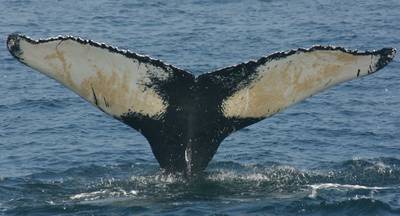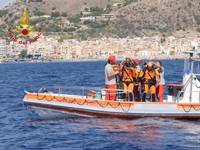Boaters Enlisted to Help Track Whales
Yachters and sailors are invited to help scientists track the movements of endangered humpback whales between NOAA’s Stellwagen Bank National Marine Sanctuary and its sister sanctuaries across the Caribbean as part of Carib Tails, a new international citizen science effort.
Carib Tails is a collaboration between the sanctuary and partners at Marine Mammal Sanctuary of the Dominican Republic, Agoa Marine Mammal Sanctuary/French Antilles, Bermuda Marine Mammal Sanctuary, the marine mammal sanctuaries of the Windward and Leeward Dutch Antilles, and the United Nations Caribbean Environment Program’s Specially Protected Areas and Wildlife Program (UNEP/SPAW).
By photographing the tails of humpbacks they encounter at sea, boaters can support on-going research to collect migration data on the shared population of approximately 1,000 humpbacks. Photographs will be matched to entries in the North Atlantic Humpback Whale Catalog and images of previously unknown and unphotographed whales will be added to the collection.
The project stresses safe boating and viewing practices around these endangered animals, which includes not approaching within 100 yards of the whales, and federal regulations apply. A dedicated website provides tips on how to photograph flukes for research purposes, photo submission forms and other information about humpback whales.
Researchers identify individual humpback whales by the black and white patterns on the underside of their flukes, or tails. Scars and natural pigmentation, ranging from all white to all black, along with the scalloped shaped edge of the tail, give each whale a distinct identification. Photographs of humpback flukes have allowed researchers to monitor the movements, health and behavior of individual animals since this research began in the 1970s.
At Stellwagen Bank National Marine Sanctuary, “Salt,” the sanctuary’s most well known whale and a mother of 12, was the first East Coast humpback to be named and the first of the sanctuary’s whales to be identified off the Dominican Republic.
“The story of Salt is one example of the power of collaborative science,” said Craig MacDonald, Stellwagen sanctuary superintendent. “Carib Tails is an exciting opportunity for citizen scientists to help expand and enrich our understanding of how this charismatic species connects us to our Caribbean counterparts.”
“Whales follow long-distance courses that take them to destinations similarly favored by yachters,” said Alessandra Vanzella-Khouri, UNEP/SPAW program director. “For the ocean lovers among us, what better way to respect the marine environment and add value to your travels than by becoming a citizen scientist?”
Stellwagen Bank sanctuary’s Sister Sanctuary Program began in 2007 to increase public awareness and help improve recovery of the shared population of humpback whales through joint research, monitoring, education and other programs.
Stellwagen Bank National Marine Sanctuary encompasses 842 square miles of ocean, stretching between Cape Ann and Cape Cod offshore of Massachusetts. Renowned for its biological diversity and remarkable productivity, the sanctuary is famous as a whale watching destination and supports a rich assortment of marine life, including marine mammals, seabirds, fishes and marine invertebrates. The sanctuary’s position astride the historic shipping routes and fishing grounds for Massachusetts’ oldest ports also makes it a repository for shipwrecks representing several hundred years of maritime transportation.





